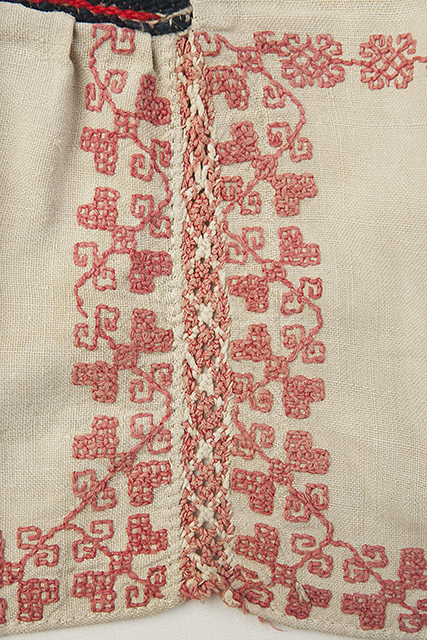Today I will talk about another costume from western Ingria which combines some elements of the last two costumes which I covered in this blog. I believe that this is a costume of the Votes, although I am not completely certain. This seems to be most typical of the district of Narvusi, although I believe it was also worn in Soikkola. There is one chemise of this type which may have been collected in Ropsu. This map shows Ingria, the Baltic Sea is on the left, The Karelian Isthmus at the top, Russia to the bottom right and Estonia at the bottom left.
The cut of the chemise is similar to the rekko costume, in that there are two rectangles over the shouders, connected by rectangular embroidered pieces in the front and back. The embroidery itself is very different, there is no gathering, and it often includes stitching in white. Here are front and rear views of one chemise.
Again, most of this material is from the Finnish Museums Online website.
http://suomenmuseotonline.fi/en

A closeup of the embroidery on the sleeves.
Sketches of the embroidery.
A second chemise, front and back.
Embroidery closeups.
A third chemise.
Notice the prevalence of swastikas in the designs. This is a very ancient and honorable symbol, and we should not let the actions of a single group of people color the past.
graphs of this chemise.
This costume is worn with a double apron, a very old type of dress. The aprons are covered with bargello or brick stitch embroidery, possibly on a colored background, or just on linen. It is difficult to tell without being able to examine the articles themselves. Here is one such pair, front and back.
At some point the two aprons were sewn together with an embroidered linen gore on one side, and panels sewn to the bottom edges. This when put on gives the impression of embroidery on the lower part of the chemise. A couple of examples of this 'skirt'. This is sometimes called kelstinat.
Notice that the embroidery on the lower linen part resembles the Holbein type of embroidery which we have seen already, and which is also done by the Russians in the northwest.
This is put on so that the dark panels hang front and back, the embroidered gore is on one side, and the opening on the other side is covered by a hip apron, as in the costume which I covered in my last posting. A shorter, wider piece of linen is hung from a sash on the front. This is also embroidered in a similar manner.
Here is a doll wearing this costume.
A couple more examples of this type of 'skirt'.
If you look closely at the doll, you will see that she has two narrow ornaments hanging from her belt in back. These are called kaatterit, they are ornamented with embroidery, cowries, coins, and beadwork. These are a common type of ornament among the ancient Finnic tribes. Many similar ornaments are worn with the costumes of the Volga Finnic peoples. Here is a view of one pair, front and back, and a detail.
In front, an embroidered linen cloth was hung from the sash. This is similar to the hip aprons worn by the last costume I wrote about, but is shorter and wider.
A narrower hip apron, like the ones shown in my last posting, is hung on one side to cover the opening. Sometimes these seem to have been tied around the waist. Many of these are preserved.
A headpiece is worn, similar to but distinct from the sorokka, called sappano. I have reason to believe that this term is Votic. It consists of a piece which ties over the forehead, and another which hangs down the back, but is sewn together differently than the sorokka. The embroidery on the back often resembles the embroidery on the front of the chemise, and the embroidery on the forehead piece resembles that on the sleeves. Some of the women which i showed in my last posting are wearing this type of headdress, as in this photo.
Here are some examples.
Another ornament is worn under the sappano. This consists of a linen strap which passes over the top of the head with beaded ends that hang on the temples. Sometimes there is a cord which is looped behind the ear. This is called ohimokoru.
You can see the woman at the top of the article and the doll are both wearing one of these.
I have only been able to find a few photos of this costume.
. The woman in the middle is wearing a version of the Tuutteri rekko costume with a misinterpreted sarafan, and the woman on the left is wearing a 'Lutheran Finnish' costume, which is worn by more recent settlers from Finland during the period of Swedish domination.
Thank you for reading. Altogether i find this to be an amazing and beautiful costume, with a great deal of detailed embroidery which is quite impressive. I hope that some of you will take some of these designs and do something creative with them. Help the Votes keep their creative tradition alive at least in some measure. It is interesting that some of this embroidery is similar to that of the Southern Khanty.
http://folkcostume.blogspot.com/2011/02/hello-all-i-would-like-to-talk-today.html
Feel
free to contact me with requests for research. I hope to eventually
cover all of Europe and the Former Russian Empire/Soviet Union. I also
gratefully accept tips on source materials which i may not have. I also
accept commissions to research/design, sew, and/or embroider costumes
or other items for groups or individuals. I also choreograph and teach
folk dance.
Roman K.
email
Source Material:
Most of this material is from the Finnish Museums Online website.
http://suomenmuseotonline.fi/en
L. Molotova, 'Folk Art of the Russian Federation', Leningrad, 1981






















































